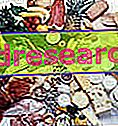What's this
What is pork fillet
Pork tenderloin - in English "pork tenderloin" - is notoriously the finest cut of meat obtained from domestic pig ( Sus scrofa domesticus ); it has a soft consistency, a delicate taste, a good nutritional profile and, compared to the other muscles of the animal, an excellent digestibility - which can vary depending on the cooking method, the seasoning and the composition of the recipe or the overall meal.

A source of high biological value proteins, specific vitamins and minerals, pork fillet belongs to the first fundamental food group. We must not forget that it is also a source of cholesterol and saturated fats - not as many as would be expected - as well as purines and phenylalanine - molecules that can interfere with certain metabolic pathologies.
Pork tenderloin is consumed practically all over the world. The firings that mostly interest this cut of meat are: roast - baked or grilled or spit-roasted, natural or in crust, etc. - in a frying pan and frying, etc. Pork tenderloin is the only cut of this animal that can be cooked just a little, although it is not entirely advisable to leave it pink "at the heart"; better to avoid eating raw, especially in circumstances of greater vulnerability - such as gestation.
Nutritional Properties
Nutritional properties of pork fillet
Of the first fundamental food group, pork fillet is a product rich in high biological value proteins, specific vitamins and minerals.
It has a medium-low energy intake. Calories are mainly supplied by peptides, followed by lipids; carbohydrates are absent. Proteins have a high biological value, that is they contain all the essential amino acids in the right quantities and proportions with respect to the human model. The fatty acids are predominantly unsaturated monounsaturated, followed by the saturated, while the polyunsaturated forms the less relevant portion. Cholesterol is present in significant but reasonable amounts.
Pork tenderloin contains no dietary fiber, gluten, lactose or histamine. Instead it has significant amounts of purines and phenylalanine amino acid.
From a vitamin point of view, pork fillet is a food that does not differ from the average of products belonging to the same category - meats. It contains mainly water-soluble B vitamins, such as thiamine (vit B1), riboflavin (vit B2), niacin (vit PP), pyridoxine (vit B6) and cobalamin (vit B12), while they are absent or irrelevant ascorbic acid (vitamin C) and all the liposoluble (vit A, vit D, vit E, vit K).
Also with regard to mineral salts, the pork fillet does not differ too much from its group. The content of phosphorus and zinc is appreciable. The amount of iron, which should be significant, does not fully meet this expectation. It also brings potassium.

| Pork fillet | |
| Nutritious | Quantity' |
| water | 76.00 g |
| Protein | 20.95 g |
| Lipids | 2.17 g |
| Saturated fatty acids | 0, 70 g |
| Monounsaturated Fatty Acids | 0.79 g |
| Polyunsaturated Fatty Acids | 0.37 g |
| Cholesterol | 65.0 mg |
| TOT Carbohydrates | 0.0 g |
| Starch / Glycogen | 0.0 g |
| Soluble Sugar | 0.0 g |
| Food fiber | 0.0 g |
| Soluble | 0.0 g |
| Insoluble | 0.0 g |
| Power | 109.0 kcal |
| Sodium | 53.0 mg |
| Potassium | 399.0 mg |
| Iron | 0.98 mg |
| Football | 5.0 mg |
| Phosphorus | 247.0 mg |
| Magnesium | - mg |
| Zinc | 1.89 mg |
| Copper | - mg |
| Selenium | - mcg |
| Thiamine or vitamin B1 | 1.00 mg |
| Riboflavin or vitamin B2 | 0.34 mg |
| Niacin or vitamin PP | 6.68 mg |
| Vitamin B6 | 0.78 mg |
| folate | 0.0 mcg |
| Vitamin B12 | - mcg |
| Vitamin C or Ascorbic Acid | 0.0 mg |
| Vitamin A or RAE | 0.0 RAE |
| Vitamin D | 0.0 IU |
| Vitamin K | 0.0 mcg |
| Vitamin E or Alpha Tocopherol | 0.22 mg |
Hygiene
Hygienic aspects of pork fillet
Pork consumption has non-negligible hygienic implications. This animal is exposed to the risk of parasitosis from Trichinella spiralis and Toxoplasma gondii, two organisms that can also infest humans. Moreover, although rare in farm animals, it is better not to ignore the hypothesis of bacterial contamination from Salmonella and Yersinia . For these reasons, despite the predisposition to fast cooking, even the pork tenderloin must be consumed exclusively cooked - changing color to the heart of the food, ie reaching 69-72 ° C.
Diet
Pork fillet in the diet
Pork tenderloin is a food that could be included in most dietary regimes, including the normolipidic slimming diet; it is in fact one of the few cuts of pork that, even in fattening specimens, expresses an acceptable fat content.
Pork tenderloin, rich in high biological value proteins, is very useful in the diet of those who find themselves in conditions of increased need for all essential amino acids; for example: pregnancy and lactation, growth, extremely intense and / or prolonged sports, old age - due to an eating disorder and a tendency to geriatric malabsorption - pathological malabsorption, recovery from specific or generalized malnutrition, debasement etc.
For the reasonable content of cholesterol and saturated fats - as well as other types of cuts: chicken breast, turkey, lean veal and horse meat - it can be used in the diet against hypercholesterolemia, as long as the portion and frequency consumption are acceptable. Note : in food therapy against dyslipidemia it is however less appropriate than fish - pinnutes properly called - rich in omega 3 (EPA and DHA).
Did you know that ...
The fatty acid profile of the meat can change radically depending on the lifestyle - especially the diet - conducted by the animal. For example, the black pigs bred in semi-wild state in the nebrodi (Sicily), which feed mainly on hazelnuts, acorns and bulbs, have a concentration of omega 6 much higher than the specimens fed with traditional feed. For more information, see also: "Omega6 (ω6) in pork".
It is a neutral food for diets aimed at subjects suffering from hyperglycemia or type 2 diabetes mellitus, hypertriglyceridemia and hypertension.
Pork tenderloin is one of the products to be avoided, or to be consumed with extreme moderation, in case of severe hyperuricemia - a tendency to gout - and calculosis or renal lithiasis with uric acid crystals. It should be completely removed from the phenylketonuria diet. It shows no contraindications for lactose intolerance, histamine - as long as it is fresh meat - and for celiac disease.
Compared to the first fundamental group of foods, towards which the bio-available iron is a "specific" mineral, the pork fillet is a not appreciable nutritional source. It does not participate as it should in the coverage of metabolic needs, higher in fertile, pregnant women, in marathon runners and in vegetarians - especially in vegans. Note : iron deficiency can lead to iron deficiency anemia. Pork tenderloin contributes to the coverage of phosphorus, a very abundant mineral in the body - particularly in the bones in the form of hydroxyapatite, in the phospholipids of cell membranes and in nervous tissue, etc. The zinc content - essential for hormone production and antioxidant enzymes - is more than appreciable. Pork tenderloin is not to be considered an essential source of potassium, but still participates in satisfying the organism's request - greater in case of increased sweating, for example in sports, increased diuresis and diarrhea; the lack of this alkalizing ion - necessary for the membrane potential and very useful in the fight against primary arterial hypertension - induces, especially related to lack of magnesium and dehydration, the onset of muscle cramps and general weakness.
Pork tenderloin is very rich in B vitamins, all coenzymatic factors of great importance in cellular processes. It can therefore be considered an excellent support for the functioning of the various body tissues.
It is not allowed in the vegetarian and vegan diet. It is inadequate for Hindu, Buddhist, Muslim and Jewish food.
Due to the hygienic aspects we discussed in the dedicated paragraph, after total cooking, it is also allowed in the diet during pregnancy.
The average portion of pork tenderloin is 100-150 g (about 110-165 kcal).
Kitchen
Cook the pork tenderloin
Pork tenderloin is consumed almost all over the globe, especially north of the equator, but indistinctly between east and west. Due to its value and above-average cost, it is hardly an ingredient of mixed minced meat, hamburgers, stuffed pasta, salami and sausages.
Pork tenderloin lends itself to many different preparations. The methods of heat transmission can take advantage of conduction, convection and radiation; the temperatures are almost always high and the times generally low - the only exception is the specific method of low temperature cooking.
Unlike beef fillet, pork does not lend itself to raw preparations such as tartare and carpaccio, especially for hygienic reasons, but also for the organoleptic and taste characteristics of the food.
Among the most widespread techniques and cooking systems we mention: roast - baked, grilled and spit-roasted - sautéed - in a pan - and fried - in vegetable oil or animal fat.
Some famous pork fillet recipes are: fillet with pepper (green or pink), fillet in bread crust, fillet in salt crust, grilled fillet, pork fillet with wine sauce, fried breaded fillets of pork fillet, pork tenderloin escalopes, etc.
The food and wine pairing of pork tenderloin depends on the recipe and the ingredients that accompany it; generally red wines are preferred, which may have more or less structure depending on the case. Some are: Oltrepò Pavese Pinot Nero and Supertuscans for the more sober recipes, Chianti Classico, Rosso di Montalcino, Rosso Piceno, Valpollicella and Terre di Franciacorta Rosso for the larger ones.
Description
Description of pork tenderloin
The pork fillet has a conical, elongated, dark pink color - which becomes more intense as the age of the animal increases. The flavor is characteristic, more delicate than the other pork cuts; the tender consistency.
The scientific name of the fillet is "psoas"; each animal has two, one per side / half side. It is a muscle of the hind quarter of the animal. It has a sublombar position - that is, it is placed below the vertebrae - and, joined to the iliac, it is part of the hypoaxial group. Note : the sublombar muscles are not considered as trunk muscles. Determines the arching of the spine and, more precisely, of the lumbosacral tract.
It is important to specify that the fillet is not the loin, which is instead part of the lumbo-thoracic multifidus, one of the epiaxial supralum bodies. Also called "sirloin", the loin is the primary muscle of the hemp and the carré. Although very close, these two cuts of meat have quite different characteristics. The two loins - one per side / half-length - support the entire structure of the animal and participate intensely in maintaining posture, walking and running; on the other hand, the fillets - especially in farm animals - are never energetically solicited. Moreover, ileopsoas and lumbo-thoracic multifidus have a percentage of connective tissue, but above all a distribution of the same, very different from each other; this is the main characteristic that determines the softness of the fillet and the greater tenacity of the sirloin.



